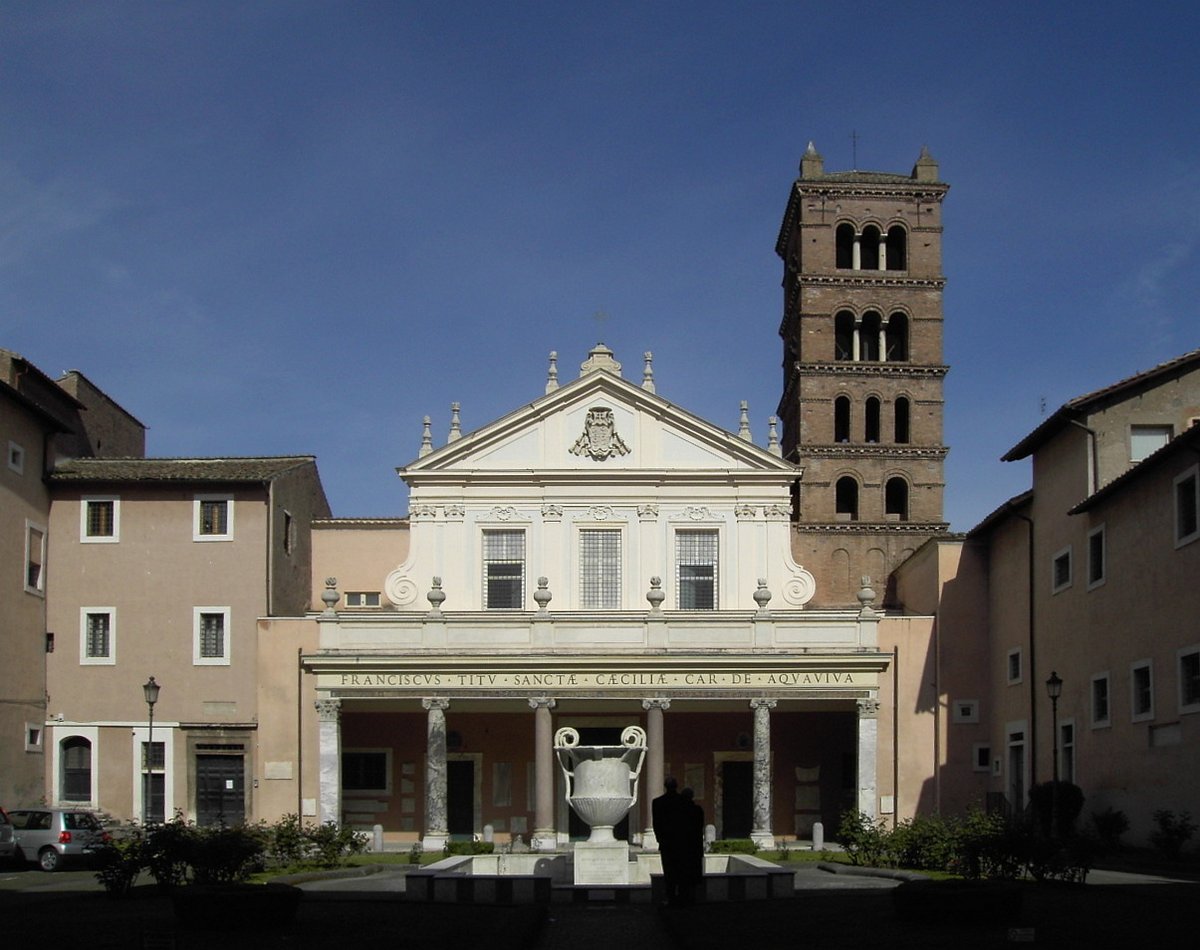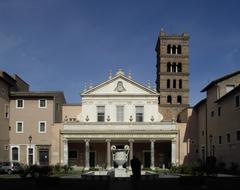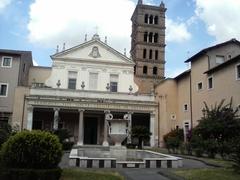
Santa Cecilia in Trastevere: Visiting Hours, Tickets, and Historical Significance in Rome
Date: 14/06/2025
Introduction
The Basilica di Santa Cecilia in Trastevere is one of Rome’s most cherished and historically significant churches, offering visitors a gateway to early Christian history, architectural evolution, and artistic splendor. Dedicated to Saint Cecilia—patron saint of music and martyrs—the basilica is believed to be built atop the noblewoman’s family home, where she was martyred around 230 A.D. This connection makes the site both a spiritual landmark and a vital destination for pilgrims, art lovers, and history enthusiasts (Iubilaeum 2025; turismoroma.it).
Situated in the vibrant Trastevere neighborhood, the basilica showcases a blend of Early Christian, Romanesque, and Baroque architecture. Masterpieces such as the 9th-century apse mosaic, Arnolfo di Cambio’s 13th-century marble ciborium, and Stefano Maderno’s poignant statue of Saint Cecilia are among its highlights. Beneath the church, the crypt and archaeological remains provide a direct connection to Rome’s ancient past (HelloMondo; VisitRome Substack).
This comprehensive guide delivers all essential details for visiting Santa Cecilia in Trastevere, including opening hours, tickets, accessibility, and historical context to ensure a rewarding experience at one of Rome’s most evocative historical sites.
Table of Contents
- Historical Overview
- Visiting Information
- Architectural and Artistic Highlights
- The Crypt and Archaeological Remains
- Musical Heritage
- Etiquette and Visitor Tips
- Nearby Attractions
- FAQ
- Visual and Interactive Resources
- Conclusion and Call to Action
- References
Historical Overview
Origins and Early Christian Foundations
Santa Cecilia in Trastevere stands as a testament to the early Christian community in Rome. Tradition holds that the basilica was constructed atop the home of Cecilia, a noblewoman martyred circa 230 A.D. for her commitment to the Christian faith—particularly for converting her husband Valerian and his brother Tiburtius. After enduring torture in a calidarium (hot steam room) for three days, she was ultimately beheaded. Pope Urban I, who is said to have witnessed her suffering, ensured her body was buried with dignity, later consecrating her home as a place of worship (Iubilaeum 2025; turismoroma.it).
Since its foundation, the basilica has served as a revered pilgrimage site, believed to house Cecilia’s relics and provide a sacred space for veneration (christianedirectory.com).
Visiting Information
Opening Hours and Admission
- Monday to Saturday: 9:00 AM – 12:30 PM and 4:00 PM – 6:00 PM
- Sunday and public holidays: 9:00 AM – 1:00 PM
- Official website for updates: benedettinesantacecilia.it
Admission to the basilica is free. Donations are appreciated to support the maintenance and preservation of this historic site (colosseumrometickets.com).
Guided Tours and Special Events
Guided tours (available in several languages) provide deeper insight into the basilica’s art, architecture, and the life of Saint Cecilia. Special liturgical events, particularly on Saint Cecilia’s feast day (November 22), and concerts celebrating the church’s musical heritage, are held throughout the year. Tours can be arranged through local operators or online platforms, and may include access to restricted areas like the convent’s choir (HelloMondo; colosseumrometickets.com).
Accessibility
The basilica’s main nave and courtyard are accessible to visitors with limited mobility. Ramps are provided at the entrance, and accessible restrooms are available. However, areas such as the crypt and convent choir may have stairs and uneven flooring. Advance contact is recommended for visitors requiring special assistance.
Location and Getting There
- Address: Piazza di Santa Cecilia, 22, 00153 Roma RM, Italy
- Public transport: Tram line 8 (Piazza di San Cosimato stop), buses 23 and 280, and the nearby Trastevere train station
- Travel tip: The Trastevere district is best explored on foot; wear comfortable shoes for cobblestone streets and extended walking (thetouristchecklist.com).
Architectural and Artistic Highlights
The Apse Mosaic
The 9th-century apse mosaic is a masterpiece of early Christian art. It depicts Christ the Redeemer flanked by Saint Cecilia and other saints, all set against shimmering gold backgrounds. The iconography reflects themes of salvation and intercession, with Saint Cecilia portrayed with a martyr’s crown. This mosaic is a rare surviving example of medieval Roman artistry (HelloMondo).
Ciborium by Arnolfo di Cambio
The basilica’s 13th-century marble ciborium, designed by Arnolfo di Cambio, stands over the main altar. Supported by four porphyry columns, its exquisite Gothic detailing marks the transition from Romanesque to Gothic styles and highlights the sanctity of the altar (HelloMondo).
Statue of Saint Cecilia by Stefano Maderno
Stefano Maderno’s 1600 marble statue, placed in front of the altar, is a moving depiction of the saint as her body was found during the 1599 excavations. The lifelike, serene figure captures the emotional impact of Cecilia’s martyrdom and is a focal point for veneration (HelloMondo).
Baroque Enhancements
Major Baroque renovations in the 17th and 18th centuries, particularly the façade by Ferdinando Fuga, enriched the basilica with ornate stuccos, frescoes, and gilded decorations. This harmonious blend of ancient and Baroque elements creates a layered visual narrative (HelloMondo).
The Crypt and Archaeological Remains
Beneath the basilica lies the crypt, where visitors encounter remnants of Roman-era structures believed to be Cecilia’s family home. Ancient frescoes, tombs, and mosaic fragments evoke the early Christian community and offer a tangible link to the past (VisitRome Substack).
Musical Heritage
Saint Cecilia’s legacy as the patroness of music is honored throughout the basilica’s history. The church’s renowned acoustics make it a sought-after venue for sacred music and special concerts, especially on her feast day. This living tradition underscores the basilica’s role as both a spiritual and cultural landmark (HelloMondo).
Etiquette and Visitor Tips
- Dress modestly: Shoulders and knees should be covered.
- Maintain silence: The basilica is an active place of worship.
- Photography: Permitted without flash in the main church; restrictions may apply in some areas.
- Time your visit: Early mornings or late afternoons are less crowded; check Mass schedules if you wish to attend services.
- Plan for accessibility: Contact ahead if you need special assistance.
Nearby Attractions
Enhance your visit by exploring:
- Basilica di Santa Maria in Trastevere: Known for its 12th-century mosaics.
- Janiculum Hill (Gianicolo): Offers panoramic views of Rome.
- Trastevere’s markets and eateries: Experience authentic Roman culture (thetouristchecklist.com).
Frequently Asked Questions (FAQ)
Q: Are tickets required for Basilica di Santa Cecilia?
A: No, admission is free for all visitors.
Q: What are the opening hours?
A: Monday to Saturday 9:00 AM–12:30 PM and 4:00 PM–6:00 PM; Sunday 9:00 AM–1:00 PM.
Q: Is the basilica wheelchair accessible?
A: The main nave and courtyard are accessible; some areas like the crypt may have limited access.
Q: Can I take photographs inside?
A: Yes, without flash; restrictions apply in some areas.
Q: Are guided tours available?
A: Yes, through local operators and online booking platforms.
Visual and Interactive Resources
- High-quality images of the basilica’s façade, interior mosaics, and the statue of Saint Cecilia can be found on official tourism and travel sites.
- Interactive maps and virtual tours are available on the official basilica website and travel platforms.
Conclusion and Call to Action
The Basilica di Santa Cecilia in Trastevere is a vital chapter in the story of Rome—where centuries of faith, artistry, and history converge. Free admission, accessible visiting hours, and the opportunity to experience masterpieces of art and architecture make this site a must-see. Combine your visit with nearby Trastevere attractions for a comprehensive Roman experience.
For the latest updates, guided tour options, and personalized travel tips, download the Audiala app. Explore more of Rome’s historical treasures through our related articles and follow us on social media for real-time inspiration and updates. Begin your journey into the heart of Rome’s spiritual and cultural legacy today!
References and Further Reading
- Santa Cecilia in Trastevere: A Historical and Visitor’s Guide to One of Rome’s Most Venerable Churches, Iubilaeum 2025
- Visiting Basilica di Santa Cecilia in Trastevere: Hours, Tickets, and Artistic Highlights, HelloMondo
- Santa Cecilia in Trastevere: Exploring Its Religious Significance and Visitor Information, turismoroma.it
- Basilica di Santa Cecilia Visiting Hours, Tickets, and Travel Tips, colosseumrometickets.com
- The Monumental Complex of Santa Cecilia, VisitRome Substack
- The Basilica of Santa Cecilia, trastevererome.com



















































































































































































































































